Microsurgical Reconstruction of Receded Gingiva Using Alloderm In Esthetic Zone-Juniper-Publisher
Juniper Online Journal of Orthopedic & Orthoplastic Surgery
Case History
Patient aged 34 years reported to the department of
Periodontology with the complaint of long corner tooth with sensitivity.
On clinical examination, gingival recession was observed on maxillary
right canine (Figure 1).
Diagnosis was made as Miller's Class I gingival recession with 13.
Coronally advanced flap with alloderm with microsurgical approach was
planned. Patient's consent as well as ethical clearance was obtained
prior to the surgical intervention. Following administration of local
anesthesia, the tooth with the recession was root planed. A
split-thickness flap with two vertical releasing incisions with micro
scalpels was raised with microelevaters, and the papillae were
de-epithelialized (Figure 2). Alloderm was measured, cut and rehydrated before suturing it with chromic gut 5-0 covering the defect as shown in Figure 3.
The flap was coronally moved and secured to the de-epthelialized
papillae over the alloderm with interrupted sutures (5-0 black braided
silk) as shown in Figure 4. Pressure was applied before placing the periodontal dressing on surgical wound. Sutures were removed on 10th day
and healing was found to be satisfactory (Figure 5).
Healing is generally uneventful in minimally invasive surgery. Patient
was evaluated after 3 months; there was 100% coverage of a denuded root
with satisfactory gingival thickness and color match with microsurgical
reconstruction of lost gingival (Figure 6).
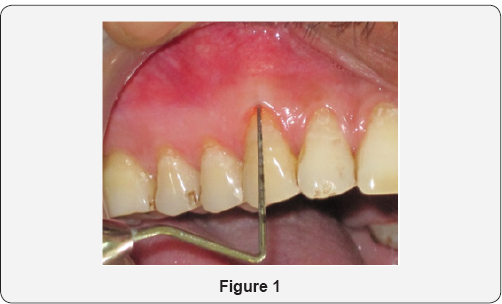
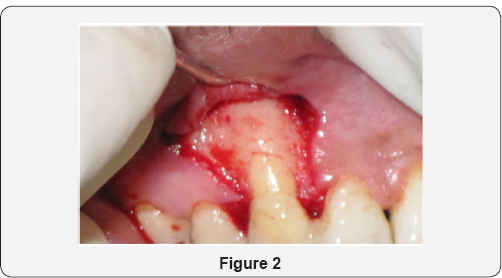
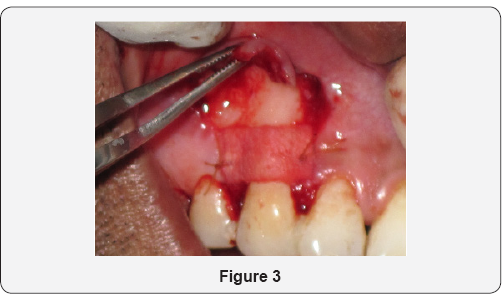
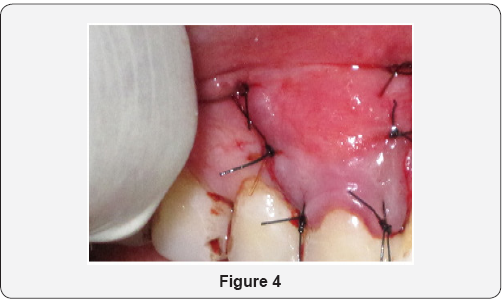
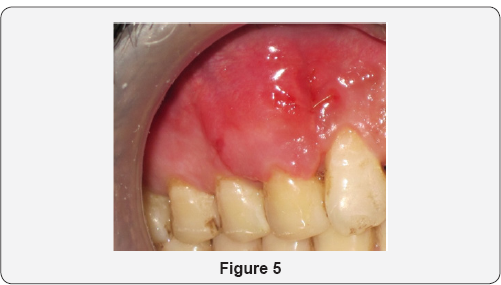
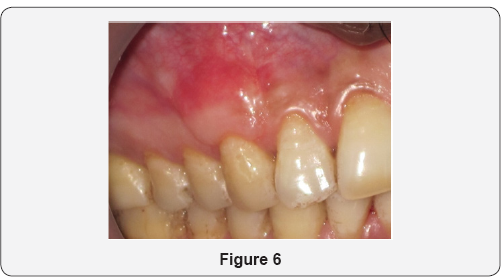
Discussion
Root exposure resulting from apical recession of
marginal gingiva can create esthetic concerns for a patient. As the
length of teeth increase, there is loss of gingival symmetry as well as
increased sensitivity, susceptibility to caries and concern over
retention of teeth. Restorative coverage of root can reduce sensitivity
or treat caries but cannot decrease the length of clinical crown,
restore lost periodontal support or prevent further gingival recession.
Various types of root coverage procedures are free autogenous graft, (gingival and connective tissue), pedicle flaps (lateral and coronal) and guided tissue regeneration with resorbable and non resorbable membranes. [1].
Pedicle flaps and Guided tissue regeneration are
viable root coverage procedures but both techniques have limitations
that reduce their clinical applicability. Nabers introduced the free
gingival graft in 1966 and Sullivan and Atkins made further refinement
in 1968. As originally described, graft was palatal keratinized mucosa
(epithelium and connective tissue) approximately 1 mm thick. This type
of graft was found to be unpredictable for covering roots due to
sloughing of the grafted tissue over the avascular root surface. In the
early 1980s, Miller and Holbrook & Ochsenbein described the
technique of thicker grafts with better predictability. However these
grafts do not blend with the adjacent tissues and are readily identified
as thicker and lighter in color. Moreover palatal wound remain exposed
and heal with secondary intention. In 1985 Raetzke and later Langer and
Langer described the use of connective tissue
graft for root coverage. In this technique, epithelial component is
eliminated from the graft and palatal connective tissue is transplanted
over the recipient bed covered by gingival flap. The retained superior
flap maintains the esthetics of the original tissue and acts as a source
of epithelial cells migrating over the connective tissue graft. These
grafts are very successful for root coverage and blending with the
adjacent tissue producing high esthetic results. Several modifications
of this technique have been proposed and connective tissue grafts are
considered the gold standard for treatment of gingival recession [6-8].
However, this technique involves a certain degree of
discomfort to the patient because an additional palatal donor site has
to be prepared, increasing the risk of postoperative pain and
hemorrhage. Recently, an Acellular dermal matrix graft has been used as a
substitute for the palatal donor sites to increase the width of
keratinized tissue around the teeth and implants and for root coverage
procedures [9-11].
Processing of the dermis obtained from human donor removes all cells,
leaving a structurally intact connective tissue matrix composed of
type-I collagen. Harris [9]
reported the use of this acellular dermal matrix graft with coronally
positioned flap for the treatment of gingival recession. The Acellular
dermal matrix consistently integrated into the host tissue, maintaining
structural integrity of the tissue and revascularized via preserved
vascular channels. The color match obtained was also reported to be
comparable to that of the connective tissue graft.
Microsurgical reconstruction with minimally invasive
technique is performed with magnification and microsurgical instruments
and suture materials. Combination of small instruments and delicate
surgical technique allows for extremely fine and accurate incisions,
gentle tissue handling, and precise approximation of wound margins [1].
Conclusion
Present case report is the excellent example of root coverage using Alloderm for the management of gingival recession with coronally advanced flap. Minimally invasive approach using magnification and microsurgical instruments has demonstrated wonderful results due to minimal tissue trauma and reduced healing time. Minimal intervention periodontal plastic surgery especially in esthetic zone significantly contributes to improve the smile in short span of time.
To read more articles in Journal of
Orthopedic & Orthoplastic Surgery
To
Know More about Juniper Publishers click
on: https://juniperpublishers.com/



Comments
Post a Comment